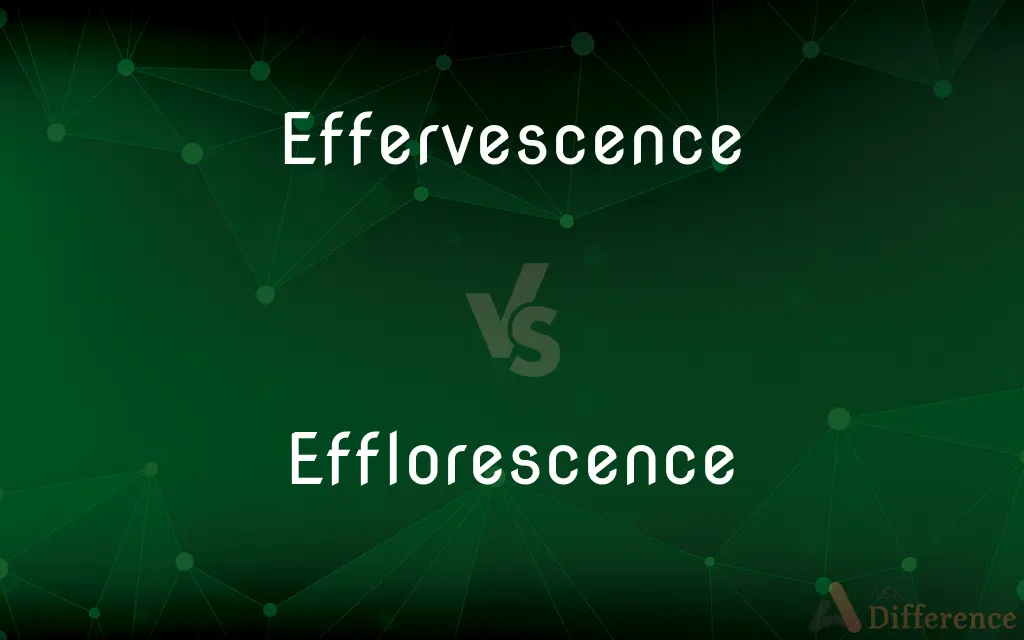Effervescence vs. Efflorescence — What's the Difference?
By Tayyaba Rehman — Updated on October 11, 2023
Effervescence refers to bubbles in a liquid, often from gas release, while efflorescence denotes the crystalline deposits of salts on surfaces, typically seen on concrete.

Difference Between Effervescence and Efflorescence
Table of Contents
ADVERTISEMENT
Key Differences
Effervescence and efflorescence, while both related to chemistry and materials, are distinct phenomena. Effervescence is the production of bubbles in a liquid, a visual manifestation of a gas being released, often carbon dioxide. Sodas and sparkling wines are common examples where effervescence is both seen and felt on the tongue, giving these beverages their characteristic fizzy sensation.
In contrast, efflorescence refers to the migration of a dissolved salt to the surface of a porous material, where it crystallizes upon evaporation. This term is frequently associated with masonry, where white, powdery deposits become visible on brick, stone, or concrete surfaces. Efflorescence can be an indication of potential structural problems in buildings if not addressed, as it reveals the presence of moisture within the structure.
Effervescence can also be described in metaphorical contexts, where it represents liveliness or vivacity. For example, one might speak of the "effervescence of youth." Efflorescence, however, is predominantly used in the literal sense, especially in the realms of architecture and construction. It's a term that architects, builders, and homeowners might discuss when dealing with moisture-related issues in structures.
To grasp the difference, think of a carbonated drink. The bubbles rising are a direct result of effervescence. If that same drink were to spill on a porous surface and leave a residue as it dried, that residue, if formed by migrating salts, would be akin to efflorescence. However, while effervescence is often desired, as in beverages, efflorescence is typically an unwanted occurrence, signaling potential material degradation.
Comparison Chart
Definition
Bubbles forming in a liquid due to gas release.
Crystalline deposits of salts on porous surfaces.
ADVERTISEMENT
Common Uses
Beverages, chemical reactions.
Masonry, construction materials.
Context
Often positive, indicating freshness or liveliness.
Typically negative, indicating moisture problems.
Metaphorical Usage
Can denote liveliness or vivacity.
Rarely used metaphorically.
Related to
Chemistry, especially reactions producing gas.
Building and construction, particularly in relation to moisture issues.
Compare with Definitions
Effervescence
Vigor or enthusiasm.
His effervescence for the project was contagious.
Efflorescence
The crystallization of salts on surfaces due to water evaporation.
The brick wall showed signs of efflorescence after the rainy season.
Effervescence
The process of producing bubbles in a solution.
The tablet's rapid effervescence made it dissolve quickly in water.
Efflorescence
The white, powdery deposits often seen on masonry.
Efflorescence was evident on the basement walls.
Effervescence
The quality of being sparkling or vivacious.
The city had an effervescence that never seemed to dim.
Efflorescence
The action or process of developing and unfolding as if coming into flower.
The efflorescence of her talent became evident in her late twenties.
Effervescence
Bubbling in a liquid due to gas release.
The effervescence in the soda made it refreshing.
Efflorescence
The process of salt migration to a material's surface.
Efflorescence on the tiles indicated an underlying moisture issue.
Effervescence
Liveliness and excitement.
The party had an effervescence that lasted all night.
Efflorescence
The period or state of flowering.
The garden was in full efflorescence during spring.
Effervescence
Effervescence is the escape of gas from an aqueous solution and the foaming or fizzing that results from that release. The word effervescence is derived from the Latin verb fervere (to boil), preceded by the adverb ex.
Efflorescence
In chemistry, efflorescence (which means "to flower out" in French) is the migration of a salt to the surface of a porous material, where it forms a coating. The essential process involves the dissolving of an internally held salt in water, or occasionally in another solvent.
Effervescence
To emit small bubbles of gas, as a carbonated or fermenting liquid.
Efflorescence
(Botany) A state or time of flowering.
Effervescence
To escape from a liquid as bubbles; bubble up.
Efflorescence
A gradual process of unfolding or developing.
Effervescence
To show high spirits or animation.
Efflorescence
The point or time of greatest vigor; the culmination.
Effervescence
The escape of gas from solution in a liquid, especially the escape of carbon dioxide from a carbonated drink.
Efflorescence
(chemistry) The formation of a powdery surface on crystals, as a hydrate is converted to anhydrous form by losing loosely bound water of crystallization to the atmosphere.
Effervescence
Vivacity.
Efflorescence
(botany) The production of flowers.
Effervescence
Foment.
Efflorescence
(construction) An encrustation of soluble salts, commonly white, deposited on the surface of stone, brick, plaster, or mortar; usually caused by free alkalies leached from mortar or adjacent concrete as moisture moves through it.
Effervescence
A kind of natural ebullition; that commotion of a fluid which takes place when some part of the mass flies off in a gaseous form, producing innumerable small bubbles; as, the effervescence of a carbonate with citric acid.
Efflorescence
(geology) An encrustation of soluble salts, deposited on rock or soil by evaporation; often found in arid or geothermal environments.
Effervescence
The process of bubbling as gas escapes
Efflorescence
(metaphorical) Rapid flowering of a culture or civilisation etc.
Effervescence
The property of giving off bubbles
Efflorescence
(pathology) A redness, rash, or eruption on the skin.
Efflorescence
Flowering, or state of flowering; the blooming of flowers; blowth.
Efflorescence
A redness of the skin; eruption, as in rash, measles, smallpox, scarlatina, etc.
Efflorescence
The formation of the whitish powder or crust on the surface of efflorescing bodies, as salts, etc.
Efflorescence
The period of greatest prosperity or productivity
Efflorescence
Any red eruption of the skin
Efflorescence
The time and process of budding and unfolding of blossoms
Efflorescence
A powdery deposit on a surface
Common Curiosities
Is effervescence limited to beverages?
No, effervescence can occur in various chemical reactions and natural processes.
Is efflorescence harmful to buildings?
It can indicate moisture issues, which might compromise the structure if not addressed.
Can efflorescence be removed from surfaces?
Yes, there are specialized cleaners that can help remove efflorescence, but addressing the underlying moisture issue is crucial.
Can effervescence be felt?
Yes, it's the fizzy sensation felt when drinking carbonated beverages.
Are effervescence and efflorescence the same thing?
No, effervescence is about gas bubbles in a liquid, while efflorescence concerns salt deposits on surfaces.
Can effervescence occur in non-liquid substances?
Primarily, it's associated with liquids, but gases can also exhibit effervescence when they pass through liquids.
Is efflorescence an indication of poor construction?
Not necessarily. While it indicates moisture presence, it might result from various factors, including environmental ones.
Are efflorescence deposits always white?
Typically, they appear white, but the color might vary depending on the type of salt and other impurities.
Can effervescence be artificially created in beverages?
Yes, carbonation machines and processes inject CO2 to produce the effervescence.
Does effervescence affect the taste of beverages?
Yes, it can provide a tangy or sharp sensation, often perceived as "fizz" or "bite."
What causes efflorescence on masonry?
It's caused by water bringing soluble salts to the surface, which crystallize as the water evaporates.
Can effervescence be harmful?
Generally, it's not harmful. However, in specific chemical reactions, the gas produced might be hazardous.
Does paint prevent efflorescence?
Painting over an affected area can temporarily mask efflorescence, but it doesn't solve the underlying issue. The efflorescence might even peel or damage the paint over time.
Why is efflorescence often seen on old brick walls?
Older constructions might lack modern moisture barriers, making them more susceptible to moisture intrusion and efflorescence.
Share Your Discovery

Previous Comparison
Coddle vs. Cuddle
Next Comparison
Attic vs. GarretAuthor Spotlight
Written by
Tayyaba RehmanTayyaba Rehman is a distinguished writer, currently serving as a primary contributor to askdifference.com. As a researcher in semantics and etymology, Tayyaba's passion for the complexity of languages and their distinctions has found a perfect home on the platform. Tayyaba delves into the intricacies of language, distinguishing between commonly confused words and phrases, thereby providing clarity for readers worldwide.














































